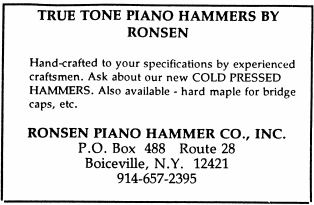Page 2
|
Minutes of the February Meeting
The meeting of L.I.-Nassau Chapter was held at Gary Schultz's Pianos Direct! showroom-warehouse in Farmingdale, NY on Tuesday, February 15, 2005 in a joint technical with the Suffolk County Chapter. The meeting was attended by a total of 17 technicians, 6 from the L.I.-Nassau Chapter. The presentation was given by Don Mannino from Kawai, in two sessions with an intermission for dinner. Don's discussion began at 4:15 p.m. with a comparison between the production RX series of Kawai pianos with their ultimate Shigeru models. Soundboard construction and features and inner rim structure, as well as wood types, beam designs, and bridge construction were all addressed. Don went into great depth on Kawai hammer design and construction, including moldings, felt densities, pressing methods, and tonal preparation and considerations. The presentation continued with a comprehensive discussion of the new ABS-carbon material used for action parts, in addition to the zinc die-cast brackets and non-adjustable action rails. Factory procedures for chipping, tuning and achieving stability were discussed, with visuals of the "torture machine." Don then fully discussed Kawai's regulation goals for tonal production, which included everything from bedding, to string stiffness, seating, and leveling, and related tools, to parts alignment and travel, to damper lift and timing, to knuckle position and friction, to aftertouch and let-off. The first session concluded with Don's voicing sequence, and a demonstration of his needling, filing, and sanding techniques. A dinner break was taken at 6:15 p.m.
by Michael Slavin - Vice President 
|
The second half of the technical resumed at 7:20 p.m. with a series of ultra high-speed films of Kawai's Millennium III action in motion, and the superior performance of its ABS-carbon material. A history of Kawai action design ensued, touching upon cost vs. assembly considerations, advantages of the butterfly-type repetition spring, and Kawai's design goals of strength and lightness, faster repetition, and super power combined with fine control, and evenness and consistency of touch. Don also indicated that even different types of glue and the nature of the glue collar itself in relation to tone production are taken into account in Kawai action design. The presentation concluded at 9:30 p.m.
Tech Tip
At the last meeting, Don Manino discussed leaking strings
on grands. This happens when the strings don't have a
good bend at the capo bar. The sound is dead and sometimes there are
buzzes. When you pull up on the strings, front and back of the capo bar,
it gives the strings more of a bearing point and stops them from leaking.
I've found that some Steinway uprights (model 1098) have the same problem.
If you find dead and buzzing strings on uprights, you can often fix them
by pushing down on the strings with a screw driver right at the last bearing point before the speaking
side, and on the speaking side of the strings. You can tell if it worked by
plucking the strings directly above the speaking side. If the strings ring out
less than they did before you pressed on them, and the speaking side sounds
a little better also, that means it helped. It doesn't always work perfectly, but it will help, because some Steinways,
both uprights and grands, have had bearing problems in their plate design.
by Paul Eccardt, Chapter President |